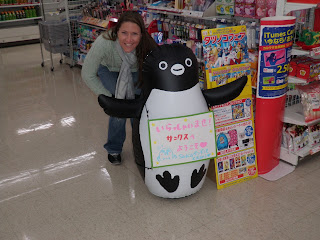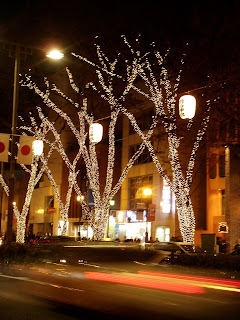Walking through the streets of Tokyo, I couldn’t help but get the feeling that I could be anywhere—Chicago, San Francisco, Atlanta; the large buildings casting shadows, the tropical breeze from the metro station stairs, the street vendors with the latest product you just can’t live without—it’s the same just about everywhere.
Aside from the foreign language on the billboards, the cars driving on the left hand side and being the ethnic minority, we could have been in almost any other city.
But, as with people, the bones don’t make the city what it is.
Barring defect, we all have ten carpals, two femurs and a mandible in common, but it’s hardly the skeletal system that defines us as individuals. It’s the personality that lies within that makes me different from you, and it’s the same that makes Tokyo different from anything I’ve ever experienced.
It’s a one-hour “rapid” train ride south from our city of residence. I caught myself reading my latest addiction about five minutes into the trip and immediately snapped it shut.
The book will be there tomorrow (or later, when it’s dark) but the Japanese countryside will certainly not.
The farther we got from “civilization” (a term I use loosely because Japan is quite the civilized area) the more incredible the homes became. Acres and acres of farmland separate tiny neighborhoods of five to eight homes cuddled together inside a protective wall.
But as Tokyo approached, space became a relative term.
Houses stack on top of each other and the skyline became rugged with structure. A quarter of the country’s population resides in the greater Tokyo area, making it (by far) the largest metropolitan area in the world.
Over 35 million residents live in a 5,200 square-mile radius. That’s 6,800 people per square mile in an area about three-fourths the size of New York City.
The train stopped in Akihabara, the “electrical city” of Tokyo. It’s the area in town to purchase your tech dream, but it was the Starbucks and a human Denny’s ad that immediately caught my eye—a reminder that you’re never too far from home.
We walked through the city as if the only survivors of a civilization-ending plague. Being New Year’s Day—which is the Japanese equivalent of combining Christmas and Thanksgiving and 4th of July and Easter—the vast majority of people were celebrating with their families and visiting shrines in keeping with Japanese tradition.
From now on, I will strive to always visit countries during their most popular holidays.
We made our way from Akihabara south to the Nihonbashi Bridge then turned west toward the Imperial Palace, a 3-mile walk lined with empty restaurants and darkened show rooms.
We meandered through the streets, admiring the bold yellow of the winter foliage, unusual architecture and the interesting city layout. Roads are built as bridges that travel the length of rivers, presumably to save space.
I also couldn’t help but be that eccentric American taking advantage of my anonymity in a foreign land.
There’s a Japanese credit card company that uses a penguin as its mascot, and it places inflatable penguins in stores to remind you that if you had its credit card, you wouldn’t have to pay with cash. (Unlike in America, plastic payment isn’t the norm.)
Seeing this penguin from the street, I boldly walked into the empty convenient store and had Ray take a picture of me with the inflatable creature. (To those who don’t know me: I love penguins.)
The woman behind the counter stared with the condescending eye most foreigners get in the States, and she probably had a good laugh over a few beers that night telling her friends about the crazy Americans who are obsessed with penguins.
By the time we arrived at the Imperial Grounds, I wished I had stopped along the way for food. Three miles in the cold can work up an appetite… or maybe I’m just obsessed with eating.
I digress.
The Imperial Grounds are immaculate and beautiful. Imagine the White House, with sprawling gardens, stone walls and a moat in the center of downtown New York. Multiply its size by three and you nearly have a mental image of Tokyo’s Imperial Palace.
We plan to return to Tokyo later in our stay to take a tour of the botanical gardens that surround the palace, but we still spent some time walking the outskirts of the palace grounds. Basically, all you can see is a moat and a wall and some gates.
The palace is closed 363 days of the year, save the emperor’s birthday (December 23) and January 2. On those days, people are allowed to enter the royal compound and see the royal family as they come out onto the balcony.
The keisatsu (police) were busy making preparations for the swarm of crowds, which must range in the millions based on the looks of the setup. Think Best Buy on Black Friday, only there’s one Best Buy that everyone must visit to purchase their toys.
From the Imperial Palace, we headed west to the area of Harajuku. My guide book told us that this was the area to see at Christmas time because the decorations were fabulous, and they were.
From the Imperial Palace, we headed west to the area of Harajuku. My guide book told us that this was the area to see at Christmas time because the decorations were fabulous, and they were.
We took the metro to save time, which merits a paragraph or two on its own.
If you’ve never been on a metro in the States, let me tell you this: they’re disgusting. I would rather risk injury or death by standing unsupported than touch anything in those cabins.
But it’s very different in Japan.
Here, people take pride in their work, their things and their surroundings. Unlike in the States, where people live with the attitude, “Someone else will clean up after me,” the Japanese take the responsibility on themselves as individuals to maintain and improve the things with which they’re entrusted.
In schools, the students spend time everyday cleaning the campus.
In Tokyo, I watched a woman sweep the sidewalk, not for trash (which is nonexistent—you don’t see litter anywhere) but for leaves and twigs that had fallen from the trees.
I saw an officer deep cleaning the metro ticket turnstiles (faceplates removed and everything).
As for the cars—they’re immaculate.
Let’s put it this way: if I dropped a piece of buttered toast face down in one of these metro cars, I would have few reservations about picking it up and eating it.
Unfortunately, I didn’t have buttered toast to still my growling stomach, which turned out to be okay.
Once in Harajuku, we ate at a hole-in-the-wall ramen shop (the name of which I’m not even sure) on a whim and lucked out. The guide book recommended a gyoza shop in that area, and we wandered up and down a few streets before throwing in the towel at our stomach’s demand.
And we were glad we did.
 |

The dish was miso-based and served with pork, bamboo shoots (as I like to call them), noodles and some seaweed. I’m still not a fan of the weed itself, but it adds a nice flavor.
The consistency of the broth told me that I was not going to enjoy it. But unlike that fourteenth marshmallow that causes your belly to scream, “Uncle!” the broth held it’s own with my palate.
Harajuku is a major fashion/shopping district, and it was there we saw the most people of all other areas in the city combined. We explored the side streets, filled with tiny street vendors and shops hailing their praises through bullhorns, then headed south to see one of the busiest intersections in the world: the neighborhood of Shibuya.
From the second floor of the Shibuya Crossing Starbucks you can see the bustle of the area. The four-way intersection has three lanes in each direction and is so large that a diagonal crosswalk bisects it to save transit time.
A big advertising medium here seems to be driving billboards, which is crazy with gas being 145 yen-per-liter, or around $7.12 a gallon. The large semi trucks drive from one large intersection to another in circular fashion (the two we kept noticing “followed” us from Harajuku to Shibuya) blasting music and bright lights to gain attention.
We caught another metro from Shibuya Crossing to Toranomon, in the Roppongi district, and walked south to see Tokyo Tower, in a round-about sort of way. For future reference, walking towards a 333-meter-tall tower doesn’t necessarily get you to the tower.
 |
| Tokyo Tower |
Modeled from the Eiffel Tower, Tokyo Tower is a communications hub that makes its money selling tours to visitors and its airspace to cell phone and television companies.
You can go up as high as 250 meters, but since it was night and hazy we stopped at the 150-meter mark.
This is where I tell you how much I hate heights.
I boldly bought tickets and stepped into the elevator without thinking for a second just how high 150 meters really is. The glass elevator really did me in.
The metric system, by the way, isn’t all it’s cracked up to be. Cold temperatures seem colder, warm temperatures don’t seem as cozy and distance is misleading, causing you to step foot into one of the highest buildings in the world without giving it a second thought.
 |
| Overlooking Tokyo |
There’s a lookout window in the floor on the level beneath the main observatory. Being separated from a nearly 500-foot drop by a piece of glass is enough to make one vomit. Or, in my case, dry heave. But when in Rome, or, in this case Tokyo, you have to just do things because you’ve been given the opportunity. Plus, I’m not one to let my fears stop me from experiencing life.
It took Ray four times before we finally got the camera to take a picture of me with the brain-splattering ground below. I was dizzy and almost threw up from sitting on the lookout window for 60 seconds. Pathetic, I know.
But I did it!!
After leaving the tower, we tried to see the Zōjō-ji Shrine, which is tucked just behind Tokyo Tower and reportedly beautiful at night with the glowing tower overhead.
Unfortunately, we made it too late and all the lights were off, making it too dark to get any pictures. We’ll return to the spot when we visit again next week and hopefully get some shots.
Tokyo’s character makes it stand out more than any other area I’ve visited, and I look forward to making it back at least once more during my stay. Although my travels have been anything but extensive, I’d like to think I can recognize rarities when I see them.
Upon further investigation, I’m convinced even the city’s metacarpals are structured differently from the bones of rival towns. It’s defined by more than just what meets the eye.










